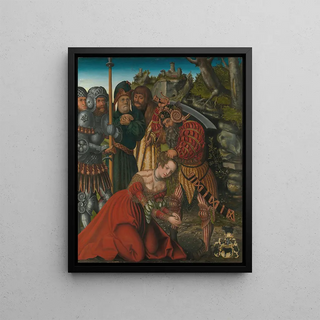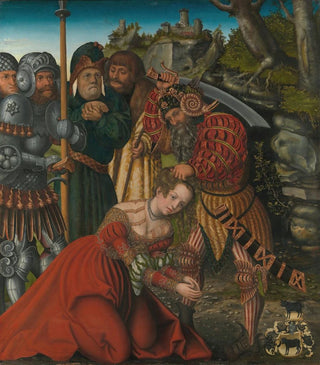Art print | The Martyrdom of Saint Barbara - Lucas Cranach the Elder


View from behind

Frame (optional)
In the fascinating world of Renaissance painting, "The Martyrdom of Saint Barbara" by Lucas Cranach the Elder stands out for its dramatic intensity and iconographic richness. This emblematic work, which evokes the sacrifice of the saint, transports us to a time when faith and suffering were deeply intertwined. The depiction of Saint Barbara, often associated with protection against storms and dangers, is portrayed here with an emotional depth that resonates with the viewer. Through this art print, we are invited to explore not only the intricate details of the composition but also the symbolic narratives hidden behind each brushstroke.
Style and uniqueness of the work
Lucas Cranach the Elder's style is characterized by refined elegance and a palette of vibrant colors. In "The Martyrdom of Saint Barbara," warm hues blend with darker shades, creating a striking contrast that enhances the emotional impact of the scene. The representation of the saint, surrounded by narrative elements, is both realistic and imbued with a certain idealization, typical of Cranach's art. The expressive faces of the characters, the flowing drapery, and the ornamental details demonstrate undeniable technical mastery. This work not only narrates a religious event; it also evokes universal themes such as courage, faith, and resilience in the face of adversity, allowing for a profound connection with the viewer.
The artist and his influence
Lucas Cranach the Elder, active in the early 16th century, is one of the most emblematic artists of German Renaissance. His work, rich in symbolism and innovation, profoundly influenced his contemporaries and subsequent generations. As the official painter of the Wittenberg court, he skillfully combined art and propaganda, incorporating reformist elements into his compositions. His unique approach, blending realism and stylization, paved the way for new interpretations of religious subjects. The depiction of Saint Barbara in this work showcases his ability to capture the essence of the subject.

Matte finish

View from behind

Frame (optional)
In the fascinating world of Renaissance painting, "The Martyrdom of Saint Barbara" by Lucas Cranach the Elder stands out for its dramatic intensity and iconographic richness. This emblematic work, which evokes the sacrifice of the saint, transports us to a time when faith and suffering were deeply intertwined. The depiction of Saint Barbara, often associated with protection against storms and dangers, is portrayed here with an emotional depth that resonates with the viewer. Through this art print, we are invited to explore not only the intricate details of the composition but also the symbolic narratives hidden behind each brushstroke.
Style and uniqueness of the work
Lucas Cranach the Elder's style is characterized by refined elegance and a palette of vibrant colors. In "The Martyrdom of Saint Barbara," warm hues blend with darker shades, creating a striking contrast that enhances the emotional impact of the scene. The representation of the saint, surrounded by narrative elements, is both realistic and imbued with a certain idealization, typical of Cranach's art. The expressive faces of the characters, the flowing drapery, and the ornamental details demonstrate undeniable technical mastery. This work not only narrates a religious event; it also evokes universal themes such as courage, faith, and resilience in the face of adversity, allowing for a profound connection with the viewer.
The artist and his influence
Lucas Cranach the Elder, active in the early 16th century, is one of the most emblematic artists of German Renaissance. His work, rich in symbolism and innovation, profoundly influenced his contemporaries and subsequent generations. As the official painter of the Wittenberg court, he skillfully combined art and propaganda, incorporating reformist elements into his compositions. His unique approach, blending realism and stylization, paved the way for new interpretations of religious subjects. The depiction of Saint Barbara in this work showcases his ability to capture the essence of the subject.






